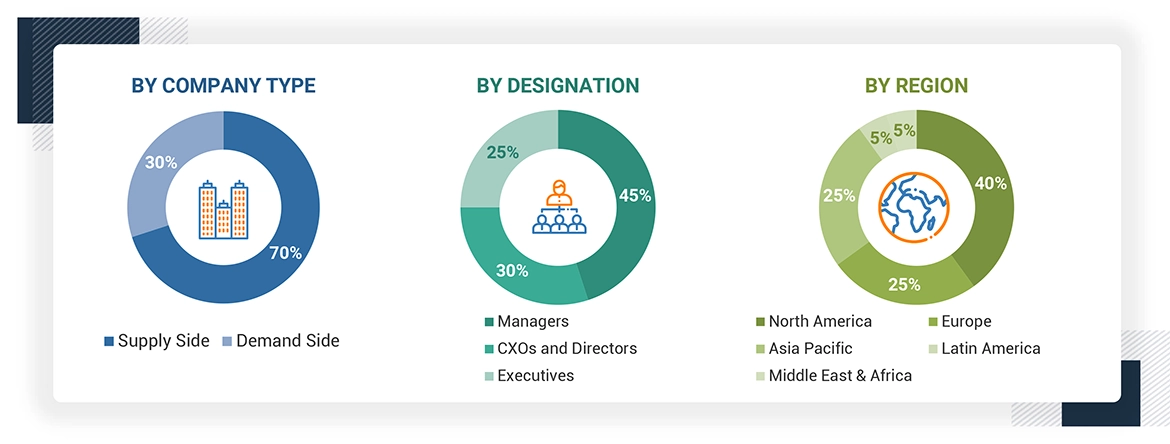The research study involved the wide use of secondary sources, directories, and databases to identify and collect valuable information for the analysis of the global synthetic biology market. Extensive interviews were conducted with various primary participants, including key industry members, subject-matter experts (SMEs), C-level managers of leading market players, and industry consultants, to obtain and verify qualitative and quantitative information and evaluate the growth scenarios of the market. The global market size is estimated through secondary research (top-down and bottom-up) followed by data triangulation with inputs from industry experts to arrive at the final market size.
Secondary Research
Secondary research was used mainly to identify and collect information for the technical, market-oriented, and commercial study of the synthetic biology market. The secondary sources used for this study include World Health Organization (WHO), Organisation for Economic Co-operation and Development (OECD), Lens.org, National Center for Biotechnology Information (NCBI), Imperial College Centre for Synthetic Biology, Institute of Systems & Synthetic Biology (iSSB), University of California San Francisco (UCSF), Center for Systems and Synthetic Biology, Synthetic Biology Leadership Council (SBLC), Engineering Biology Advisory Committee, Synthetic Biology Engineering Research Center (SynBERC), Biotechnology and Biological Sciences Research Council (BBSRC), Helmholtz Association of German Research Centres, Asian Synthetic Biology Association, World Bank, Academic Journals and Company Websites, corporate & regulatory filings, such as annual reports, SEC filings, investor presentations, and financial statements; business magazines & research journals; press releases; and trade, business, and professional associations among others. These secondary sources were also used to obtain major information about key market players, and market segmentation corresponding to industry trends, regional/country-level markets, market developments, and technology prospects. Secondary data was collected and analysed to arrive at the market size of the global synthetic biology market, which was further validated through primary research.
Primary Research
Extensive primary research was conducted after acquiring basic knowledge about the global synthetic biology market scenario through secondary research. Several primary interviews were conducted with market experts from the demand side, such as pharmaceutical & biopharmaceutical industries from the supply side, such as C-level and D-level executives, product managers, marketing & sales managers of key manufacturers, distributors, and channel partners. The primary interviews were conducted across six major regions, including the North America, Europe, Asia Pacific, Latin America, Middle East and Africa. Approximately 70% and 30% of the primary interviews were conducted with supply-side and demand-side participants, respectively. This primary data was collected through questionnaires, e-mails, online surveys, personal interviews, and telephonic interviews.
The following is a breakdown of the primary respondents:

To know about the assumptions considered for the study, download the pdf brochure
Market Size Estimation
Both top-down and bottom-up approaches were used to estimate and validate the total size of the synthetic biology market. These methods were also used extensively to estimate the size of various subsegments in the market. The research methodology used to estimate the market size includes the following:
Data Triangulation
After arriving at the market size from the market size estimation process explained above, the total market was divided into several segments and subsegments. To complete the overall market engineering process and arrive at the exact statistics for all segments and subsegments, data triangulation and market breakdown procedures were employed, wherever applicable. The data was triangulated by studying various factors and trends from both the demand and supply sides.
Market Definition
Synthetic biology involves the redesign of natural biological systems by engineering and designing new biological parts and functions, namely synthetic biological pathways and organisms, which are used to construct end products. It is an innovative research area broadly comprising of multiple disciplines, such as biotechnology, molecular biology, genetic engineering, and biophysics, among others.
Stakeholders
-
Companies Providing Synthetic Biology Tools, Technologies, and Related Products & Services
-
Research Institutes and Academic Centers
-
Suppliers and Distributors of Synthetic Biology Tools & Technologies
-
Pharmaceutical and Biotechnology Companies
-
Agricultural and Veterinary companies
-
Business Research and Consulting Service Providers
-
Venture Capitalists
-
Contract Research Organizations and Contract Development Manufacturing Organizations
-
Market research and consulting firms
Report Objectives
-
To define, describe, and forecast the synthetic biology market by value by tool, technology, application, and region
-
To provide detailed information regarding the major factors influencing the market growth (such as drivers, restraints, opportunities, and challenges)
-
To analyze the micromarkets1 with respect to individual growth trends, prospects, and contributions to the overall Synthetic biology market
-
To analyze the opportunities for stakeholders and provide details of the competitive landscape for market leaders
-
To forecast the size of the market segments with respect to six regions: North America, Europe, the Asia Pacific, Latin America, Middle East and Africa
-
To profile the key players and analyze their market shares and core competencies2
-
To track and analyze competitive developments, such as product launches, partnerships, agreements, collaborations, and expansions
-
To benchmark players within the market using the proprietary “Company Evaluation Matrix” framework, which analyzes market players on various parameters within the broad categories of business and product excellence strategy



Meghan
Dec, 2022
Can you elaborate more on the emerging trends in the global Synthetic Biology Market?.
Kenny
Dec, 2022
Which growth strategies are adopted by key players in the global Synthetic Biology Market?.
John
May, 2022
This article looks interesting. I would like to know how many primary and secondary interviews were conducted for data validation on Synthetic Biology Market..
Billy
Mar, 2022
Can you share the detailed information on key factors Driving the growth of Global Synthetic Biology Market?.
Joe
Mar, 2022
How much share does the top companies holds, of global Synthetic Biology Market?.
Bruce
Mar, 2022
Can you elaborate more on the global geographical growth scenario for the Synthetic Biology Market?.